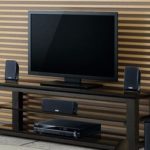Conclusion and adjustment of a sound in the home theater
The comfort of watching movies and your favorite videos can be provided with high-quality sound. To create a sound atmosphere of a large cinema at home, it is necessary choose the right and adjust the acoustics. The surround sound that surrounds the viewer allows you to get strong emotions and pleasure.
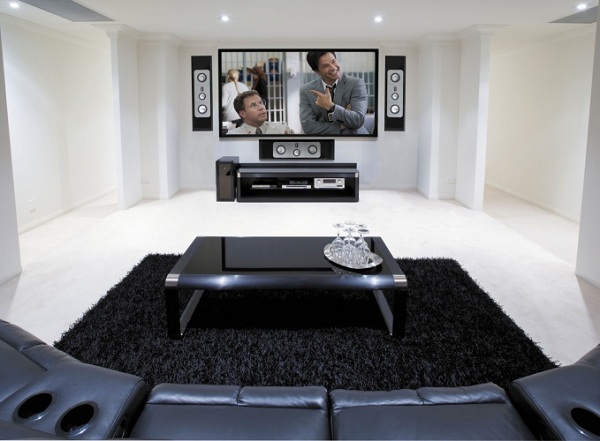
Content
How to output sound to the AV receiver
Despite the good video quality and the ability to play a 3D image on the screen of modern TVs, the sound quality is not sufficient for maximum enjoyment.The thickness of the TV screen does not allow to build in powerful acoustics to achieve surround sound. It is for these purposes that it is acquired. home theater or high-quality speakers with AV receiver. If you are not an avid film fan and are not obsessed with the perfect amplitude-frequency sound, you can use budget acoustics.
There are several options for sound output, much depends on choosing a particular home theater and TV models. Types of connection are associated with the types of connectors provided by different generations of equipment.
HDMI interface
The most modern way to transfer both sound and video. When the sound projection from the TV to the AV receiver should be supported technology ARC. In the home cinema passport information should be indicated on the possibility of connecting to the audio system via HDMI, i.e. availability of ARC. If there is such a possibility, the connection is made by connecting the cable (preferably 1.4 b) of the TV connector to the AV receiver. Next, you should make a choice in the TV settings and change the sound playback from the built-in speakers to the audio system.
Important! If, after activating the ARC function, the sound is replayed with a delay, it is likely that a poor-quality connection cable through the HDMI connector is used.
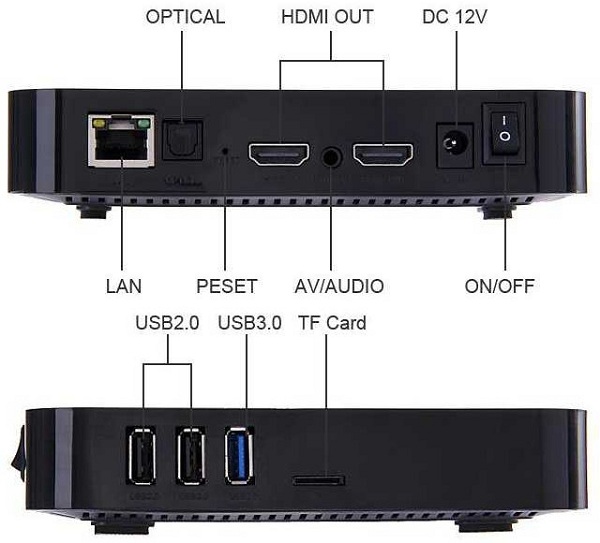
Optical output
Also, the best method is to transmit multi-channel audio through digital optical output. It is present in all modern models and guarantees high quality sound.
To switch home theater, you must use a special cable that is resistant to electromagnetic waves, thus avoiding interference and sound distortion. For these purposes, connect the connectors TV and AV receiver with the designation Optical out and Optical in respectively.
Note! The cable connects the output from the TV screen and the input of the AV receiver, otherwise, there will be no sound.
Other methods
For older models of technology, you can use the following switching options:
- In the absence of an optical output, the replacement will be coaxial connectorwhich also provides for multi-channel sound. The connection is coaxial. In this case, the choice of designation of connectors on the panel of equipment will be Coaxial out / Coaxial in.
- The most popular and familiar way of connection is a 2-connector cable (tulip) red-white color, but at the same time the quality of the audio signal slightly deteriorates. Color marking will not make a mistake when connecting connectors.
- In the absence of free output connectors for cinema / AV receiver, you can use Tv headphone outputthrough 3.5mm cable.
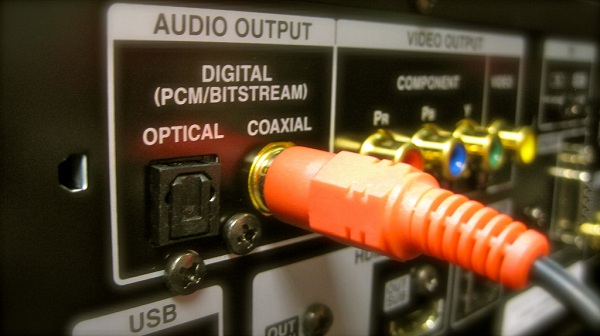
Coax Connection
Home Theater Sound Tuning
To ensure the sound level of the cinema at home is possible with proper sound tuning. Even if all the elements of acoustics are correctly arranged, the sound may not be perfect. This factor is influenced by sound insulation of walls, windows and floor.
In the presence of a powerful subwoofer, it is enough to install Small acoustics, and a crossover - 90Hz. For the whole complex to work with the test signal, you must set the mode to stereo and set the desired sound level on the speakers. For surround sound is better to use. audio spectrum analyzer True RTA Level. The following is required for setup:
- Connect the line input with the output of the sound card.
- Install Sound System Calibration.
- The output of the sound card is connected to the input of the receiver.
- Microphone connected to the sound card, set to the 80th range.
- Adjust the frequency and limits of the sound axis.
- The signal type is set to pink noise, and RTA resolution is 1/24 octave.
- Enable input signal processing
- Turn off the generator and processing after 10 seconds.
- The View - Save to Memory command will save the measurement description.
- Setting the crossover is made with each movement of the column and listened to from different places. It is necessary to fill all the memory cells.
- Select the best sound level and restore the required settings to the measurement description.
- Adjust the sound of the audio system from a subwoofer with a range of 20-500 Hz.
- The final step is to set up the center and rear speakers.
Required equipment power
To maintain the 7.1 configuration, the AV receiver has 7 amplification channels, although 5.1 is enough for an apartment. For this subwoofer must be selected with internal amplificationcapable of generating a signal gain of hundreds of watts, and which can provide good dynamics. For speakers, it is enough to gain a few dozen watts per channel to provide surround sound in a room up to 30 square meters.m
Factors affecting the choice of receiver
The big screen is not enough to transmit the full scale effect of the film product. The receiver is the "heart" of the home theater, the main function of which is the improvement of the sound range. Consider the most important points on which to rely when choosing this item of equipment.
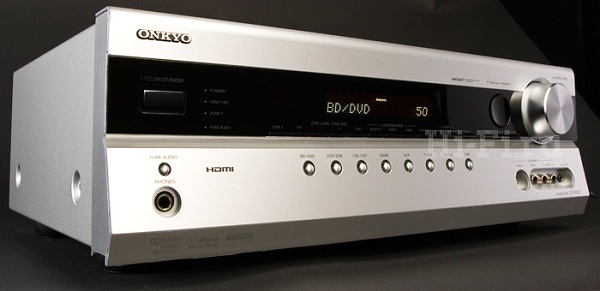
Receiver power and number of channels
The power should not exceed the output amplification of sound on the speakers: otherwise it will lead to system failure. The budget version of the receiver can reach up to 100 W, which fully provides 5.1 mode and gives high-quality surround sound in a room up to 20 square meters. m. The subwoofer has its own gain, so the total power of the speaker system is not taken into account. It must be remembered that the more power, the louder the sound. For the choice of equipment in the room over 30 square meters. m., receiver should choose more than 150 watts with a mode of at least 7.1.
In the configuration, the first digit indicates the number of columns, and the second - the number of channels. If the configuration is 7.2, then the system is two-channel and there will be 2 subwoofers.
Number of ports
The most universal types of connectors for audio and video playback is HDMI port. Using this connector, it is possible to connect any component of the equipment. To connect a home theater, their number should not be less than 3, and it is better to choose a receiver with connector stock for a possible future increase in users.
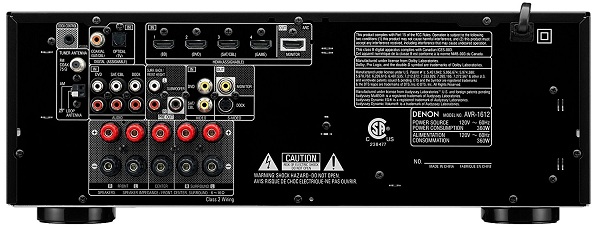
Availability of decoders and audio processors
Required decoder formats Dolby and DTS included even the simplest system. What else could be?
- for Blu-ray movies must be Dolby TrueHD and DTS-HD Master Audio;
- To listen to music you will need FLAC, AAC, Apple Loseless decoding;
- HD audio playback - D / A with a sampling frequency of more than 192 kHz.
Additional functions
Function video conversion provided mainly in models of medium and high categories. Able to convert analog signal to digital, as well as increase the resolution to Full HD. If you have a modern TV with built-in TV-tuner, this function will not be required.
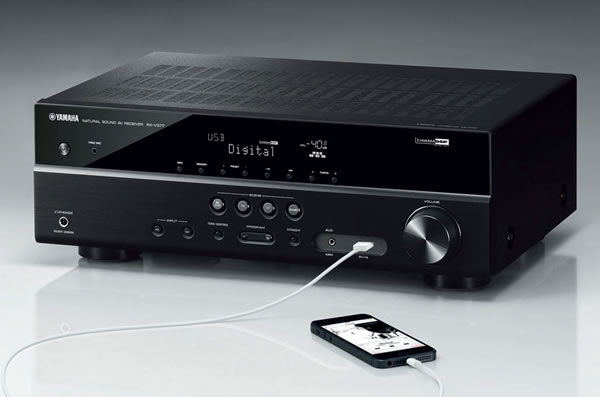
Yamaha RX-V377 / HTR-3067 equipped with a USB port
Function Standby - Passthrough ensure that the signal passes even when the receiver is turned off, when there is a need to switch playback from the speakers to the television speakers.This feature will allow you to view movies during the rest of the rest of the household.
The presence of USB-port will help to quickly start playing files from external media. Receiver Bluetooth enabled provide the ability to connect to the system via smartphones and tablets.
Relatively inexpensive receivers that have the necessary package of functions and parameters do not exceed $ 300. with full set. Most requested budget optionsthat provide high-quality video and surround sound: Onkyo TX-SR307, Denon AVR-1508, Pioneer VSX-519V, Yamaha RX-V365.
Alternative acoustics
If not satisfied with the built-in TV speakers, and large diagonal screen, you can not rush to install a home theater to provide surround sound. Alternative acoustics can be sound bar. It is an oblong box, which is placed under the TV panel with amplifiers, drivers, connectors and crossover circuits. At the heart of the sound panels is a 3-channel system (in the center and on the sides). For better sound, you can select models with 5-6 channels. The main advantage is compactness. This acoustics is often used in small apartments, where saving free space is very important. A good soundbar can provide a sound effect for a small room, which is 70% identical to a home theater.

Soundbar - an alternative to built-in TV acoustics
Note! When connecting equipment, it is important to remember that until all the cables are connected, the equipment should not be connected to the power supply network.
New to the speaker system is soundbar. This is a worthy replacement for the built-in TV acoustics, providing surround sound. It can be used as a stand, located either at the bottom or at the top of the TV. The soundbar provides for the presence of different connectors, both coaxial and HDMI. There are analog inputs, USB ports, Bluetooth. May have 2 and multichannel configurations. A subwoofer may be embedded; if it is external, it is better to arrange it in the same plane with the sound panel in order to achieve a better sound. Also, the sound quality is positively influenced by the arrangement of speakers in one row with a certain distance from each other and an angle. The acoustics are equipped with DolbyDigital and DTS decoders. Choosing a soundbarYou will get the following benefits:
- small dimensions provide high-quality surround sound;
- the ability to play any format;
- built-in players, work with external media;
- control functions can be carried out through the remote.
The soundbar and soundbar are worthy alternative approaches in ensuring the reproduction of high-quality sound that conveys the atmosphere of the cinema hall in small rooms.

/rating_off.png)






